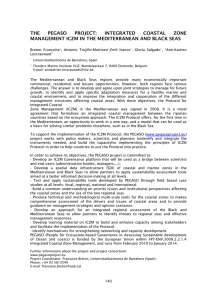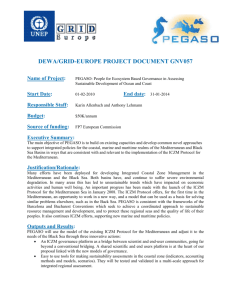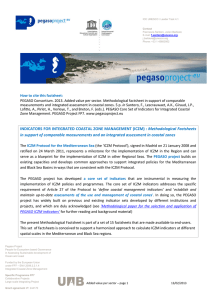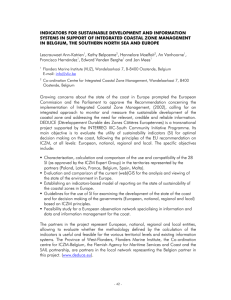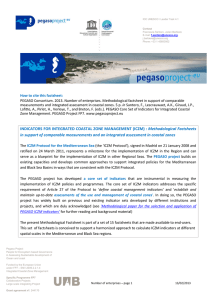Document 12460533
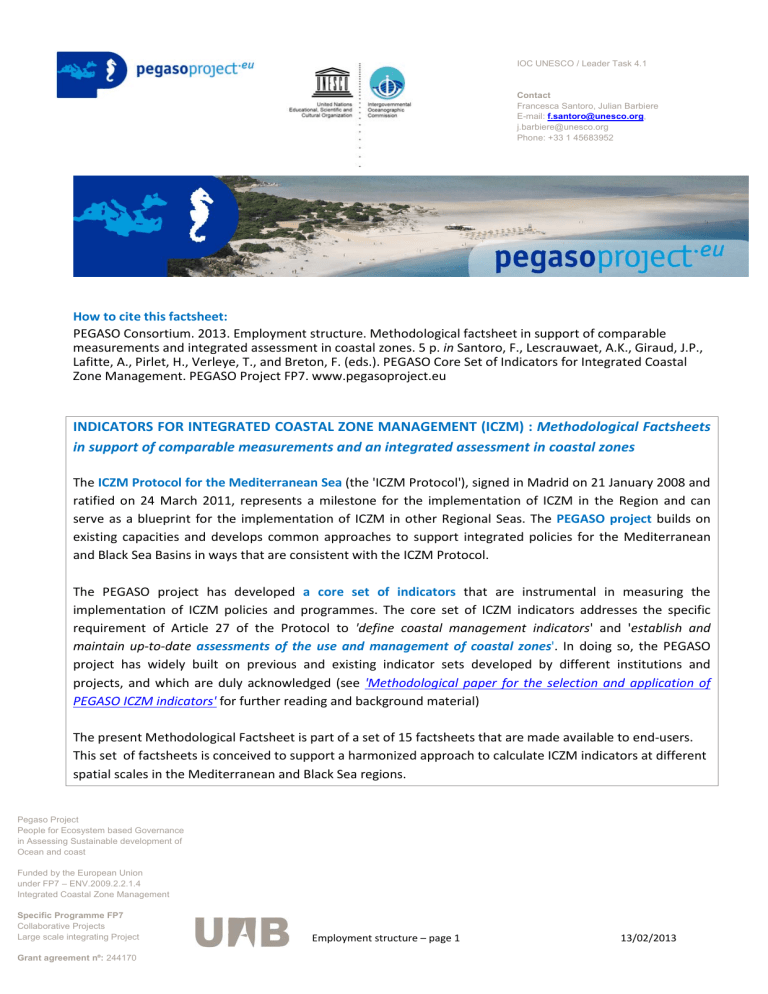
IOC UNESCO / Leader Task 4.1
Contact
Francesca Santoro, Julian Barbiere
E-mail: f.santoro@unesco.org
, j.barbiere@unesco.org
Phone: +33 1 45683952
How to cite this factsheet:
PEGASO Consortium. 2013. Employment structure. Methodological factsheet in support of comparable measurements and integrated assessment in coastal zones. 5 p.
in Santoro, F., Lescrauwaet, A.K., Giraud, J.P.,
Lafitte, A., Pirlet, H., Verleye, T., and Breton, F. (eds.). PEGASO Core Set of Indicators for Integrated Coastal
Zone Management. PEGASO Project FP7. www.pegasoproject.eu
INDICATORS FOR INTEGRATED COASTAL ZONE MANAGEMENT (ICZM) : Methodological Factsheets in support of comparable measurements and an integrated assessment in coastal zones
The ICZM Protocol for the Mediterranean Sea (the 'ICZM Protocol'), signed in Madrid on 21 January 2008 and ratified on 24 March 2011, represents a milestone for the implementation of ICZM in the Region and can serve as a blueprint for the implementation of ICZM in other Regional Seas. The PEGASO project builds on existing capacities and develops common approaches to support integrated policies for the Mediterranean and Black Sea Basins in ways that are consistent with the ICZM Protocol.
The PEGASO project has developed a core set of indicators that are instrumental in measuring the implementation of ICZM policies and programmes. The core set of ICZM indicators addresses the specific requirement of Article 27 of the Protocol to 'define coastal management indicators ' and ' establish and maintain up-to-date assessments of the use and management of coastal zones ' . In doing so, the PEGASO project has widely built on previous and existing indicator sets developed by different institutions and projects, and which are duly acknowledged (see 'Methodological paper for the selection and application of
PEGASO ICZM indicators' for further reading and background material)
The present Methodological Factsheet is part of a set of 15 factsheets that are made available to end-users.
This set of factsheets is conceived to support a harmonized approach to calculate ICZM indicators at different spatial scales in the Mediterranean and Black Sea regions.
Pegaso Project
People for Ecosystem based Governance in Assessing Sustainable development of
Ocean and coast
Funded by the European Union under FP7 – ENV.2009.2.2.1.4
Integrated Coastal Zone Management
Specific Programme FP7
Collaborative Projects
Grant agreement nº: 244170
Employment structure
Objective of the indicator
Coastal zones harbour a variety of economic activities. They can be linked to the presence of the sea (such as fishing activities, aquaculture etc). They can also be related to the existing population, as more than 40% of the world’s population live within 100 kilometres of the coast. It is important to understand how the various activities are organised in this particular geographical area. This indicator assesses the strengths and weaknesses of the coastal economy and its prospects of generating sustainable employment. This indicator also accounts for the spill-over effect and balances the following indicators: turnover, number of enterprises and added value.
This indicator gives a description of the employment by economic activity, employment status and place of work.
More precisely, this indicator answers the following questions:
What proportion of the population living at the coast is economically active?
What economic sectors are people who live at the coast employed in (i.e. in what economic sector do they work)?
Where do they work (do they work locally? somewhere else within the coastal zone? or do they commute away from the coast and work inland)?
How do they work (are their jobs full time or part time, permanent or seasonal)?
Who works (i.e. breakdown by gender, ethnicity and age)?
Do patterns of employment differ significantly between the coast and the wider reference region?
It is important to use this indicator together with the 3 other economic indicators (turnover, added Value per sector and number of enterprises) (see section on “Example of integrated assessment”).
ICZM Policy Objective
ICZM Protocol Article
UNEP-MAP Ecological
Objective
INSPIRE ANNEX I-III Data
Theme (34)
Name of the Indicator
Policy context
To give priority to public services and activities requiring the proximity to the sea, and to take into account the specific characteristics of the coastal zones when deciding about coastal uses
Article 9:
Economic activities
Population distribution and demography (Annex III – 10)
Coverage
Coastal zone of the Mediterranean Sea
Coastal zone of the Black Sea
CALCULATION OF THE INDICATOR
Spatial consideration
Resolution-Reporting Unit(s)
•
•
Coastal zone of the Mediterranean and Black Seas at
NUTS2 level
Coastal zone of the Mediterranean and Black Seas at
NUTS3 level
Note: the spatial reporting unit, or scale, may be defined by the issue or sector under consideration (see below)
Employment structure – page 2 13/02/2013
Temporal consideration
Period
Time series should be as long as possible
Minimum of three most recent census or survey
Resolution (time interval or unit)
Annual data. Measurements should be consistent in reflecting the situation for comparable reference points i.e. 1st of January or 31st of
December every year.
Select a baseline, followed by reference points e.g.
2012, 2007, 2002 …
Parameter(s)
Note:
1) The calculation method is given for NUTS3 level. It should be repeated for NUTS2 level.
2) For each parameter, the economic activities or sectors considered are the following:
Employment level for the following sectors (if relevant for the area under consideration!)
• Submarine cables
• Shipbuilding and repair, scraping…
• Extraction (marine aggregates)
• Recreational Activities (Expenditures instead of turnover)
(i)
-Bathing
-Yachting and Sport
-Recreational fisheries (including shellfish)
• Offshore oil and gas-related industry
• Electricity power production interacting with marine environment (Marine renewable energy, Nuclear plants…)
• Living resources based activities
-Aquaculture
-Professional Fisheries (including algae)
-Seafood processing and marketing
• Maritime financial services (insurance, banks, supports…)
• Transport activity
-Harbours and supports
-Transport (people and goods)
• Maritime civil engineering (harbours, dams, dikes…)
• Other sectors and activities depending on or impacting coastal and marine environment (Agro industry, Food
Processing, Chemistry…)
-Agriculture
-Other industries
-Urban sprawl
-Coastal tourism (hotels, camping, restaurants, cafes)
Employment level per sector, for sectors that are relevant in relation to the ICZM issue
Note: ‘relevant’ sectors are to be identified and selected according to a causal chain analysis (impacting sectors and impacted sectors). The employment is defined at the scale of a reporting unit which is relevant for the issue or sector under consideration: e.g. river basin, coastal NUTS5/LAU2 etc.
Calculation method
Steps
1 For each geographical scale, use the most recent time series to identify the contribution of each of the identified sectors that are relevant for the
Products
Employment level in each sector at:
- national scale
- regional scale (coastal NUTS3)
Employment structure – page 3 13/02/2013
marine/coastal economy to the local/regional economy in terms of employment.
Compare impacting and impacted sectors.
2 If employment data are available at the level of enterprises, they are often reported by means of class or intervals. In this case, the employment level will be defined as the average or median of the class.
For sectors such as Agriculture or Aquaculture presenting non payroll employment (head of the farm for instance), the average of the class will need to be increased with 0.5
Finally employment at enterprise level will be aggregated at the sector level and further to local, and regional scales.
3 Aggregate employment level for marine/coastal sectors, impacting sectors and impacted sectors.
- local scale (coastal NUTS5)
400
300
200
100
0
800
700
600
500
400
300
200
100
0
Employment level in each sector at:
- national scale
- regional scale (coastal NUTS3)
- local scale (coastal NUTS5)
Bar Chart of the employment per sector at different scales (NUTS3 and 5) for the different reported years.
Region 1 Region 2 Region 3
Year n-2
Year n-1
Year n
Bar Chart of the employment for marine/coastal sector and remaining ones at local level (NUTS5) for several years.
800
700
600
500
Year n-2
Year n-1
Year n
Marine/coastal Remaining Total
Use of the indicator in previous
Current monitoring Data sources
National databases
Assessment context
Indicators on employment structures have been developed in several programmes or initiatives.
The DEDUCE project included this indicator in its set of 27 indicators and 45 measurements for
Employment structure – page 4 13/02/2013
assessments/initiatives sustainable development in coastal zones..
DPSIR framework State
Link to anthropogenic pressure
Sustainability target or threshold
Link with other assessment tools
Example of integrated assessment
Data Harmonization
In order to build a common, regional view for a particular indicator, it is crucial to harmonize the data in terms of e.g. concepts, definitions, reporting units, colour codes, value class boundaries and scoring methods. For this purpose, the
PEGASO consortium has developed ‘Guidelines for Data Harmonization’ which are available from the ‘Products’ section on the PEGASO project website www.pegasoproject.eu. Although agreements may exist related to the presentation of certain indicators that are legally embedded, this may be less evident for indicators which are not (yet) used as an instrument within a policy context or within a region where the policy is not applicable. The PEGASO consortium encourages contributing partners, stakeholders and end-users to consult the ‘Guidelines for Data Harmonization’ document, and to actively engage in this process.
Indicator references (i.e. UNEP, EEA, …)
To get a full overview of the economic activity within the coastal zone, it is necessary to use this indicator together with the 3 other economic indicators.
The ratios Turnover/Employment and Added Value/Employment allow a comparison between the different sectors. They reveal the relative contribution of a sector to the local economy.
Scope for future improvements
Note: factsheet content drawn by the PEGASO partner University of Brest.
Employment structure – page 5 13/02/2013


